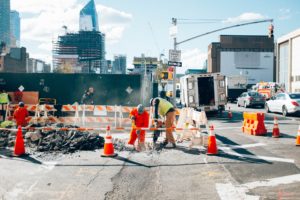
The ground we walk on is covered with asphalt for roads, concrete for sidewalks, and is naturally decorated with grass, flowers, shrubs, and trees. Intermingled within are telephone polls, electricity wires, buildings, and other structures requiring power. We all understand that natural organisms have roots that ground them and give them life, it’s taught at a young age that organisms that sprout from the earth depend upon roots which are often unseen from above the ground. Out of sight and perhaps out of mind are the over 20 million miles of underground utilities providing life to homes, businesses, traffic lights, and anything you can think of that requires power.
As referenced in a previous post, the 20-million-mile metric is almost certainly undershooting the estimate, as that figure was proposed in 1994. So, with well over 20 million miles of crucial underground utilities running beneath our feet, it would seem that protecting these lines and cables would be of the utmost importance, as well as protecting individuals who may be digging near them. Aii recently interviewed people on the streets in an effort to find out what the average citizen knows about the safety precautions surrounding these underground utilities – a field known as damage prevention.
First, some context. In these interviews, the 811 initiative was at the core of the questioning. 811 is the national phone number you must call in the United States before a digging project. Designated in 2005, 811 centers were designed to help protect subterranean powerlines, telecommunications lines, and pipes carrying water and gas.
Additionally, the depth of which these utilities are buried beneath the ground can vary depending on what is buried and where it’s being buried. AT&T spokesman Jim Kimberly told the Chicago Tribune in regard to telecommunications utilities, “our standard in Illinois is between 26 and 36 inches for direct-buried cable placed by trenching or chisel-plowing. Cables placed by the directional bore method will generally be deeper than this standard.” Electric cable can be buried anywhere between 6 and 48 inches depending on the type of cable, and natural gas lines are typically buried 48 inches deep.
These numbers are important to know even for the average citizen, such as one individual we spoke to on the street who recalled hitting a cable line while she was digging in her yard. The same individual said she was unfamiliar with the 811 service, which was not uncommon among the people we encountered.
We asked every person who was willing to talk with us the same question, “are you familiar with the 811 program?” We were often met with a short “no” or the more verbose, “I have no idea what that is.” Some people we talked to were familiar with the program but had no experience in calling nor partaking in a digging project in general.
Watch our short interview teaser here:
Of course, we only spoke to a handful of people on the streets, so it is difficult to say how well they represent the entire population. With that being said, responses were heavily skewed towards being unfamiliar with 811.
What does this mean?
811 is considered to be a tremendous accomplishment for preventing underground utility damage. Still, though, the Common Ground Alliance estimates that about 500,000 power and pipelines are hit during excavation projects each year. According to the International Risk Management Institute (IRMI), “the cost of one utility strike may rise to hundreds of thousands of dollars, and insurance will typically not cover that loss.”
If the strike to the line prevents other clients from receiving service, fines can increase, about $10,000 per hour or lost service, according to IRMI.
In 2019, CGA published a report detailing a five-year rising trend in excavation damage and an estimate that it cost the U.S. over $30 billion in economic costs in 2019 alone. Those costs include power outages and internet loss, but also deaths and injury that can occur when natural gas lines are disrupted.
There are millions of miles of utilities beneath us, the repercussions for interfering with these lines are hefty, and yet some people are still unfamiliar with how to safely navigate their digging project. The rule of thumb is that every dig requires a call. Even a simple tree planting or mailbox set up in your yard requires calling 811. They will begin the process for locators to visit your site and spray paint the area so you can see and know what is below before your shovel goes in blind!
Join us as we continue our educational series #ModernRootsMarch on social media. We want to help educate everyone and remind them to be conscious of these underground utilities when embarking on the next digging project.
Written by John Cassibry, Media Coordinator
The Alliance for Innovation and Infrastructure (Aii) is an independent, national research and educational organization. An innovative think tank, Aii explores the intersection of economics, law, and public policy in the areas of climate, damage prevention, energy, infrastructure, innovation, technology, and transportation.